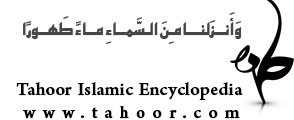
The Guardianship (Alveläyat) treatise
One of the valuble and unique works of Allame Seyyed Mohammad hossein Tabatabai is the treatise of guardianship (Alveläyat) that had been written in Arabic and while its brevity, had discussed the essential issues and unveiled the hidden secrets of religion. The late allame because himself like some of his special Masters was a wayfarer (sälek) of the path for reaching to the high position of “Friend of God”(Vali of God or valiollah) and about to start this path, therefore, he could write travelogue that is the same “the guardianship treatise”. In ####this treatise, the author has talked about “Divine guardianship” (veläyate elähi) and “Friend of God” (vali of God or valiollah) and know “the real perfection” of the “Man” possible, in the shadow of accepting the “Divine guardianship”. Meaning, “Man” be perish in “God Essence”(zäte God) and in “His abiding”, being remain; such a person deserves the title of “Friend of God” (vali of God or valiollah).
The brief biography of Author:
Seyyed Mohammad Hossein Tabatabi Tabrizi was born in 1903A.D.(1321A.H./1281solar year). He went to school one year before his father’s death, but after finishing the seventh grade, it is deemed advisable to study at home. For this reason, he and his brother learn the Arab literature under the supervision of a competent literary man by the name of “Sheikh Mohammad Ali Saräi” and also learn the art of calligraphy under the supervision of “Mirza Ali Naghi Khatät. The late Alläme, at the age of 21 in 1924A.D.(1303) married with the daughter of “the late Haj Mirza Mahdi Agha Tabatabi Mahdavi” who was his father’s relative. Aläme, in 1925A.D.(1304 S.H.), after finishing the seminary courses of Tabriz, left for the Holy Najaf along with his wife, brother and newborn son. Acquaintance with Haj Mirza Ali Aghaye Ghazi, had such influence in him, that during 11 years living in “Najaf”, in addition of jurisprudence (fegh), methodology (osool), mathematics, philosophy, Rejal and commentary, had learned the “practical mysticism”(erfän amali) at the presence of this great master and profited from “spiritual journey”(seyr and solook) and “self-purification”(Tazkiyeh Nafs). [REJAL: is a science that studying the biographies of the transmitters of Hadith]. The late Mohammad Hossein Tabatabi”, in the latter part of life, in Najaf, spend his life with difficulty, so that, in the year of 1935A.D.(1314) because of financial problems, left for Iran and dwelled in the “Shäd Äbäd” village of Tabriz. For acquisition of learning, he left for “Qom” and forever bade farewell to Tabriz. He came to “Qom” in 1944A.D.(1325) and thus began his scientific productive life. He lived in this city for about 35 years and did the most services to Islam and theological schools. He started the philosophy lesson with new style. The life of this great scholars who is one of the great glories of Islam and rare researcher, ended and died in the morning of 9 o’clock in “Qom” in 1981/11/15(1360/8/24). Some works that he provided in Tabriz consists of:
1- A treatise on Names and Attributes
2- A treatise on Acts
3- A treatise on intermediaries between God and Man
4- A treatise on before world
5- A treatise in world
6- A treatise on after world
7- A treatise on guardianship
8- A treatise on prophecy
9- Genealogy book of Azarbijan’s Tabatabies.
A brief about Alläme’s services in Qom:
1- Founding a new method of commentary that is completely new and innovative
2- The dissemination of philosophy and intellection thought
3- Efforts in explaining the philosophy subjects and making tangible of many difficult(complex) subjects
4- Try to publish the works of “Household” (p.b.u.th).
5- Coincidence between quranic concepts with whatever have been related in reports of “Household of the messenger” (khändäne resälate)
6- The dissemination of Shiite thought, outside the Islam world.
7- Training and educating scientific and intellectual personages.
8- Valuable publications whether published or unpublished..
9- etc.
The structure and division of the book:
This book, because of its importance has been pulished by different publishers in many years and have been translated by the translators such as: Hassan Zade Amoli and Sadegh Hassan Zade, etc. The book contains of 5 chapters as follow:
The first chapter: In this chapter, the late allame, for the “outward aspects of religion”(zäher Din) had proved the “inward aspect”(baten), and had used the “intellectual proof”
(dalil aghli) and “reasoning based on “revealed sources”(dalil naghli) about it.
The second chapter: In this chapter, the late allame, for making clear the quality, kind of secrets and reality of religion, explained the relationship of “the material world” (ällam mädde
), “imaginal realm”( älam mesäl) and “world of intellect”( älam aghl) with each other.
The third chapter: In this chapter, the late allame, know the way of reaching to the “inward aspect of world”(bäten älam), “Hidden Secrets” and getting in contact with “transphysics”(mävarä tabiat) possible for every one, and did not consider it only for the Holy prophets.
The fourth chapter: In this chapter, the late alläme had explained the way of reaching and getting access to the “realities intuition” (shohood haghäyegh) and “vision of God”(leghä of God).
The fifth chapter: This is the final chapter of the book and the author asserts that this chapter is the explanatory part (explanatory-like) for the subjects of chapter two.
In the book, the author had mentioned 22 Hadiths (traditions) of imam Ali(p.b.u.h) about “knowledge of the soul”(marefate nafs) and its importance.
Sources :
1- The path of mysticism (Gnosticism)/allame Tabatabai/ translator: Sadegh Hassan Zadeh
2- Shiism encyclopedia/ vol 10, page 463
3- Shiite commentators groups/vol1- page: 195/vol 6 page: 454
4- Allame Tabatabai’s bibliography/ Ghanbar Ali Kermani
5- The authors of Arabic and Persian printing- house books- vol 2 page: 863
6- Persian dictionary of proper nouns (a’läm)